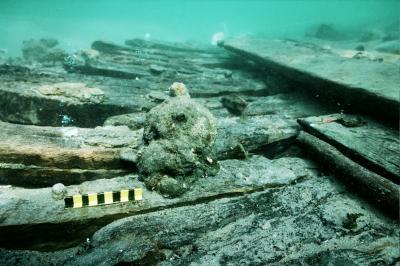Which navy commissioned the boat that sunk off the coast of Acre 200 years ago, which battles was it involved in and how did it end up at the bottom of the sea? The recent findings of marine archaeologists at the Leon Recanati Institute for Maritime Studies of the University of Haifa may provide the answers to these questions.
The ship, which sunk off the coast of Acre during a battle between Napoleon, the British navy and possibly the defenders of Acre, 200 years ago, is under excavation and its finds are beginning to shed light on Napoleon's attempt to conquer the Holy Land. Cannon ball wedged into the ship's keel. Credit: Steve Breitstein
Cannon ball wedged into the ship's keel. Credit: Steve Breitstein
Recent marine excavations found cannon balls, canisters of gun powder and other items that will help give evidence as to the ship's journey and answer the questions facing marine archaeologists. It is not clear if the boat was involved in battles in 1799 or 1840, if it was a French or British boat or even if the boat sunk or was sunk. "This is the only shipwreck excavated from the period of the French blockade of Acre and it can teach us a lot about the naval battles of that period," explained Dr. Ya'acov Kahanov from the Leon Recanati Institute for Maritime Studies and the Department Of Maritime Civilizations at the University of Haifa.
This large ship, 30 meters long and 9 meters wide, was discovered off the Acre coast in 1966, but systematic excavations have only just begun under the auspices of the Leon Recanati Institute for Maritime Studies of the University of Haifa in cooperation with the Nautical Archaeology Society of Great Britain and with the help of the Nautical College for Naval Officers in Acre. The fact that cannon balls, gun powder canisters, wineskins and metal buckles were found, attest to the fact that this ship was part of a naval fleet. The question of which battle it was involved in has yet to be answered, but the archaeologists do have some theories.
It seems that the story of this boat begins over 200 years ago. Researchers found a map in a British archive, drawn in 1799 by a British soldier, of the British formation off the coast of Acre, facing a blockade of Napoleon's ships. The map includes a symbol of a sunken ship, at exactly the spot where this ship was found. This map is the source of the theory that this ship was involved in the battles of 1799. In addition, one of the cannon balls was found wedged into the keel of the boat, exactly at the bottom. The location and the unique angle at which the cannon ball is positioned, has led researchers to believe that it was this cannon ball that sank the ship.
"One of the theories is that this is a "barricade ship" - a ship that the British purposely sunk at the entrance of the port in order to block smaller French ships from entering it. The leather buckles, gun power canisters and the rest of the finds need to be analyzed to verify how the ship ended up at the bottom of the sea. Once we understand these questions, we will be able to understand more about battle tactics of that period, "said Dr. Kahanov.